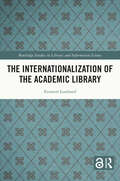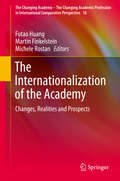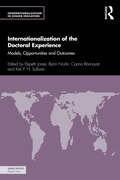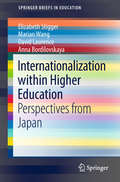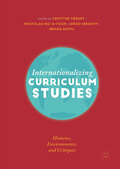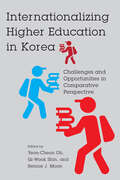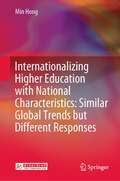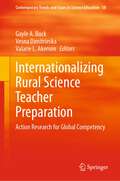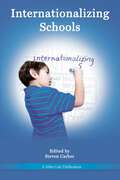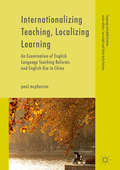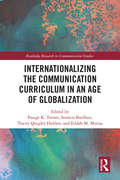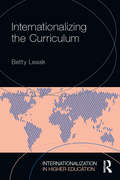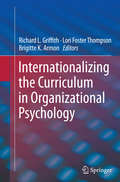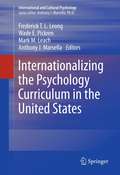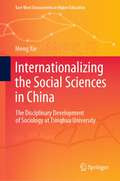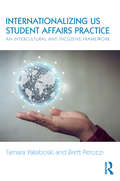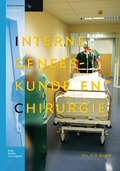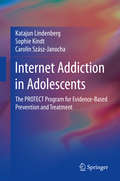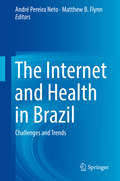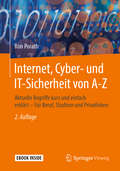- Table View
- List View
The Internationalization of the Academic Library (Routledge Studies in Library and Information Science)
by Emmett LombardThe Internationalization of the Academic Library presents a theoretically informed, empirically grounded analysis of the process of academic library internationalization. Drawing on interviews with library personnel from around the world, Lombard analyzes internationalization at the departmental level of an academic library. Demonstrating that college and library personnel have positive intentions when it comes to internationalization, the research presented nevertheless reveals that there was little commitment to an intentional, holistic role in the libraries studied. Drawing on internationalization expertise and models of prominent scholars, the book argues that libraries need to be more deliberate in their internationalization efforts and collaborate with other college personnel and departments outside the library. Lombard asserts that internationalization can facilitate a better understanding of the potential for transformation of the library’s mission, vision, and policy. This book cuts across the fields of library science and higher education administration, ensuring that the book will appeal to researchers and students working in these disciplines. Library professionals around the world will also find much to interest them within the book.
The Internationalization of the Academy
by Futao Huang Martin Finkelstein Michele RostanThis volume provides a nuanced empirical assessment of the extent to which the academic profession is internationalized at the beginning of the 21st century. It indicates which are the most internationalized academic activities, and focuses on specific topics such as physical mobility for study or professional purposes, teaching abroad or in another language, research collaboration with foreign colleagues, and publication and dissemination outside one's native country or in another language. It places the main theme in the wider context of the history of higher education's internationalization. It provides explanations on what drives and deters academics from international activity, and documents some of the consequences that internationalization has on academic work and productivity. This study is based on a survey of 25,000 academics working at higher education institutions in 18 countries and Hong Kong on five continents. Comparing data from the 1992 Carnegie International study to the 2007 CAP survey, relying on respondents' perceptions of change, and comparing different academic generations, it offers valuable insights on changes in the internationalization of the academy.
Internationalization of the Doctoral Experience: Models, Opportunities and Outcomes (ISSN)
by Elspeth Jones Björn Norlin Carina Rönnqvist Kirk P. H. SullivanThis groundbreaking book highlights the profound impact of internationalization in doctoral education, offering a variety of models to align with student interests and needs. It includes insights from over seventy contributors spanning more than thirty-five national contexts on six continents, who explore the values and benefits of internationalization at the doctoral level, such as social and cultural enrichment, academic and personal growth, network enhancement, and research collaboration, paving the way for meaningful career opportunities in academia or elsewhere. Evaluating the outcomes of internationalization and the development of researcher identities, the volume underscores the immeasurable value and impact of internationalized doctoral experiences while recognizing the importance of student agency. Reflections from students and graduates reveal the merits of international experiences but also address challenges and pitfalls, including environmental, economic, equity, and decolonization concerns.With implementable recommendations for institutions, academics, and students, this important book offers guidance for the future of internationalization in doctoral education and emphasizes the importance of strategic institutional approaches. Internationalization of the Doctoral Experience: Models, Opportunities and Outcomes is essential reading for anyone interested in the evolving landscape and transformative potential of internationalization in doctoral education.
Internationalization within Higher Education: Perspectives From Japan (SpringerBriefs in Education)
by Elizabeth Stigger Marian Wang David Laurence Anna BordilovskayaThis book discusses what internationalization practices are and the different ways that they are being implemented by higher education institutions in Japan, from a bottom-up perspective. It reflects the current situation faced by many Japanese universities in the context of the changing landscape in higher education and considerations in implementing changes to course curricula, programs, and university admissions with regard to internationalization. The four case studies presented provide readers with clear examples of how the internationalization of higher education institutions is developing within the Japanese higher education system, and the issues that different higher education institutions face in this process.
Internationalizing Curriculum Studies: Histories, Environments, And Critiques
by Bryan Smith Awad Ibrahim Nicholas Ng-A-Fook Cristyne HébertThis book seeks to understand how to internationalize curriculum without imperializing or imposing the old, colonial, and so-called first-world conceptualizations of education, teaching, and learning. The collection draws on the groundbreaking work of Dwayne Huebner in order to invite scholars into conversation with histories of curriculum studies and to posit them within it, opening up new spaces to work in and through curricular issues. This book will appeal to scholars, teachers, and students looking to reconceptualize international curriculum development and theory.
Internationalizing Early Childhood Curriculum: Foundations of Global Competence
by Nancy BrownInternationalizing Early Childhood Curriculum empowers teachers and directors to internationalize their curriculums around the world in their own unique and culturally specific ways. Serving as a guide and catalyst for thinking about curriculum in our interconnected world, this book explores how young children learn about the world and describes how children develop intercultural understanding, including how their teachers transform to expand their own global awareness and citizenship. Stories from actual classroom curriculum projects are featured, as well as suggested strategies and stages for the process of implementation. Exploring the implications for teacher education and professional development, this book gives readers the tools they need to bring internationalization into their own programs. Designed to apply to formal and informal early childhood centers across the spectrum, Internationalizing Early Childhood Curriculum is essential reading for professional developers and trainers, as well as classroom teachers, directors, policy-makers and NGO professionals providing early childhood services in the U.S. and around the world.
Internationalizing Higher Education in Korea: Challenges and Opportunities in Comparative Perspective
by Yeon-Cheon Oh, Gi-Wook Shin, and Rennie J. MoonStudent mobility in Asia has reached unprecedented levels. Inbound and outbound student mobility creates opportunities for Asian societies but also challenges, such as growing diversity and brain drain. This book examines these and other related, timely issues for the case of South Korea, a major player in the internationalization of higher education in Asia, and draws on the comparative experiences of other key players in the Asia-Pacific region—Japan, China, Singapore, and the United States. By doing so, it offers critical perspectives on the internationalization of Korean higher education as well as innovative, policy-relevant solutions for Asian countries undergoing similar challenges. It will be a valuable addition to the growing literature on comparative and international education in Asia and can aid university administrators and policymakers striving to internationalize their higher education systems to meet new challenges.
Internationalizing Higher Education with National Characteristics: Similar Global Trends but Different Responses
by Min HongIn an era of globalization, internationalization of higher education (IHE) has been constructed as an almost inevitable trend and has become a common pursuit of many nations in their higher education (HE) policies. This book focuses on two nations, China and Australia, in terms of this trend. The broadest aim of this book was to find out the interactive relationships between global and national pressures in policy development by comparing the international HE policies in China and Australia. The three categories, overarching meta-policies at the macrolevel (nation), institution focused policies at the mesolevel (universities), and people focused policies at the microlevel (individuals) are documented and analyzed. Similarities and differences are identified. Similarities include promoting and deepening IHE as one important agenda in national policies at the macrolevel in the two nations, promoting transnational cooperation in the provision of HE at the mesolevel, as well as increasing international student numbers and encouraging an outflow of student learning and exchanges at the microlevel. Differences include China’s soft power initiatives and Australia’s appeal for the sustainability of international HE as a national priority in the area of IHE at the macrolevel; the focus on “World Class Universities” construction in China and strengthening the overall HE system in Australia; and different issues in relation to people mobility and brain circulation—specifically, encouraging more outflow of students and attracting more inflow of talents and international students in China, and over-reliance on international students financially in Australia. It is suggested that different responses to the global trends reflect the specificities of each nation and the ways path-dependent factors mediate global pressures. This comparison will facilitate a better understanding of how globalization has affected and been responded to in IHE policies and enable a better understanding of their path-dependent mediation through a focus on two specific sets of national policies.
Internationalizing Rural Science Teacher Preparation: Action Research for Global Competency (Contemporary Trends and Issues in Science Education #58)
by Gayle A. Buck Vesna Dimitrieska Valarie L. AkersonThis edited volume discusses the need to increase quantity and enhance quality of science education focused on preparing rural students to thrive in an interconnected, interdependent, and complex world. It acknowledges that globally integrated education incorporates local knowledge and culture with global trends. Additionally it highlights globally competent science teaching is not included in most preparation programs, and teachers enter schools unprepared to address students’ needs. Rural schools lack opportunities to keep up with reform efforts and may have limited experiences with diversity, particularly at the global level. These chapters describe globalization in authors’ respective academic institutions by sharing global competence action research projects for preservice teachers. The studies presented were conducted in elementary and secondary science methods, and science content courses. The book’s research is unique as the contributors have carried out action research in science teacher preparation programs and participated in peer discussions that helped them fill gaps in global science teaching while advancing the field of teacher preparation programs.
Internationalizing Schools
by Steven CarberInternationalizing Schools is a collaborative work bringing together experts in the field of international education. This book discusses the many challenges experienced by the international school community and attempts to highlight how educators can begin a systemic approach to knowledge creation and sharing among independent and state funded schools, with the end result being a world-class international education available to all students in all settings around the world. Internationalizing Schools is equally relevant for all schools aiming to provide, or who are interested in providing, an international curriculum, independent and state funded schools alike.
Internationalizing Schools
by Steven CarberInternationalizing Schools is a collaborative work bringing together experts in the field of international education. This book discusses the many challenges experienced by the international school community and attempts to highlight how educators can begin a systemic approach to knowledge creation and sharing among independent and state funded schools, with the end result being a world-class international education available to all students in all settings around the world. Internationalizing Schools is equally relevant for all schools aiming to provide, or who are interested in providing, an international curriculum, independent and state funded schools alike.
Internationalizing Teaching, Localizing Learning
by Paul McpherronBased on ethnographic and policy data collected over a ten-year span at a university in the People's Republic of China, this book analyses the history of English Language Teaching (ELT) polices in Chinese higher education. The book uses the university as a lens in which to investigate the creative imaginations and divergent (re)appropriations of teaching methods, learning materials, and language use in the Chinese ELT context. Book chapters move beyond mere descriptions of tensions and point to the local understandings and practices of English teachers (both local and foreign) and students. Working together, these teachers and students are constantly articulating new social and political conditions and meanings outside and inside given discourses and traditions of ELT. The book's main argument is that these multiple stakeholders must be given a more prominent role in shaping policy and curriculum at universities and other English language contexts around the world.
Internationalizing the Communication Curriculum in an Age of Globalization (Routledge Research in Communication Studies)
by Paaige K. Turner Soumia Bardhan Tracey Quigley Holden Eddah M. MutuaGlobalization and the resulting internationalization of universities is driving change in teaching, learning, and what it means to be educated. This book provides exemplars of how the Communication discipline and curriculum are responding to the demands of globalization and contributing to the internationalization of higher education. Communication as a discipline provides a strong theoretical and methodological framework for exploring the benefits, challenges and meanings of globalization. The goal of this book, therefore, is to facilitate internationalization of the communication discipline in an era of globalization. Section one discusses the theoretical perspectives of globalism, internationalization, and the current state of the Communication discipline and curriculum. Section two offers a comprehensive understanding of the role, ways, and impact of internationalizing teaching, learning, and research in diverse areas of study in Communication, including travel programs and initiatives to bring internationalization to the classroom. The pieces in this section will include research-based articles, case studies, analytical reviews that exam key questions about the field, and themed pieces for dialogue/debate on current and future teaching and learning issues related to internationalizing the Communication discipline/curriculum. Section three provides an extensive sampling of materials and resources for immediate use in internationalization in communication studies; sample syllabi, activities, examples, and readings will be included. In sum, our book is designed to enable communication curriculum and communication courses in other disciplines to be internationalized and to offer different approaches to enable faculty, students, and administrators to incorporate and experience an internationalized curriculum regardless of time and financial limitations. This book is notable as a professional development resource for individuals both inside and outside the communication discipline who wish to incorporate a global perspective into their research and classrooms.
Internationalizing the Curriculum (Internationalization in Higher Education Series)
by Betty LeaskThe drive to internationalize higher education has seen the focus shift in recent years towards its defining element, the curriculum. As the point of connection between broader institutional strategies and the student experience, the curriculum plays a key role in the success or failure of the internationalization agenda. Yet despite much debate, the role and power of curriculum internationalization is often unappreciated. This has meant that critical questions, including what it means and how it can be achieved in different disciplines, have not been consistently or strategically addressed. This volume breaks new ground in connecting theory and practice in internationalizing the curriculum in different disciplinary and institutional contexts. An extensive literature review, case studies and action research projects provide valuable insights into the concept of internationalization of the curriculum. Best practice in curriculum design, teaching and learning in higher education are applied specifically to the process of internationalizing the curriculum. Examples from different disciplines and a range of practical resources and ideas are provided. Topics covered include: why internationalize the curriculum?; designing internationalized learning outcomes; using student diversity to internationalize the curriculum; blockers and enablers to internationalization of the curriculum; assessment in an internationalized curriculum; connecting internationalization of the curriculum with institutional goals and student learning. Internationalizing the Curriculum provides invaluable guidance to university managers, academic staff, professional development lecturers and support staff as well as students and scholars interested in advancing theory and practice in this important area.
Internationalizing the Curriculum in Organizational Psychology
by Richard L. Griffith Lori Foster Thompson Brigitte K. ArmonThis book assembles state-of-the-art thinking on the internationalization of the curriculum of training centers in I/O and Work Psychology. The experts contributing chapters share their thoughts on the knowledge and skills that students must master in the 21st century, as well as their research on how we can develop students to be globally perceptive, culturally competent working professionals. Chapters cover a full range of topics such as: the scope of subject matter and content, learning objectives and outcomes, global competencies, co-curricular activities, experiential learning and the tacit curriculum, while curriculum development must stem from the philosophy of each institution, these philosophies may diverge in focus (e. g. science versus practice) and outcomes (e. g. jobs versus mastery). Therefore, the goal of the book is not to prescribe a particular curriculum, but rather to provide insight on possible curriculum elements that may be customized for use by training institutions.
Internationalizing the Psychology Curriculum in the United States
by Mark M. Leach Wade E. Pickren Frederick Leong Anthony J. MarsellaThe psychology community recognizes that cultivating an international worldview is crucial not only to professionals and researchers, but more importantly, for professors and students of psychology as well. It is critically necessary for psychologists to learn from their colleagues who are working in different cultural contexts in order to develop the type of knowledge and psychological understanding of human behavior that will be maximally useful to practitioners and researchers alike. This volume, Internationalizing the Psychology Curriculum in the United States, provides information and resources to help psychology faculty educate and train future generations of psychologists within a much more international mindset and global perspective. Recognizing that cultural context are central to a true and accurate psychology, the authors describes how cultural, economic, political, and social factors in different countries frame individual experience and affect the science and practice of psychology. Each of the chapters will provide a content-specific overview of how the curriculum in psychology with regards to social, development, clinical, counseling psychology, etc will need to be modified in order to present a much more global view of psychology.
Internationalizing the Social Sciences in China: The Disciplinary Development of Sociology at Tsinghua University (East-West Crosscurrents in Higher Education)
by Meng XieThe current social reality and changing global forces and spaces are inspiring the rethinking, refining, and re-empowering of the world social sciences to broach the frontiers of human knowledge, enhance mutual understanding across cultures and civilizations, and shape a better world. Taking Tsinghua University’s sociology as a case, this book concentrates on how internationalization shapes disciplinary development in a global context of asymmetrical academic relations. This inquiry is set amidst China’s dramatic economic, social, political, and cultural transformations, as well as the institutional reforms in this Chinese flagship university. This book seeks to probe how Chinese and Western knowledge, institutions, and cultures are integrated in the ongoing process of internationalization and concentrates on the disciplinary evolution of Tsinghua’s sociology—intellectually, institutionally, and culturally—drawing on top-down higher education policy and bottom-up perceptions and experiences of Tsinghua’s social scientists. This book highlights that higher education internationalization is an evolving process whose advanced phase would require Chinese social scientists to bring China to the world. It is time for Tsinghua University to reassess the long-term impact of internationalization on its academic disciplines and provide sufficient support for the development of the social sciences.This book will attract academics, practitioners, and postgraduate students interested in higher education internationalization, international academic relations, global constellation and distribution of academic power, academic knowledge production, and the development and intellectual influences of the Chinese social sciences.
Internationalizing US Student Affairs Practice: An Intercultural and Inclusive Framework
by Tamara Yakaboski Brett PerozziGrounded in research and theory, Internationalizing US Student Affairs Practice presents an inclusive framework for enhancing the intercultural competencies of practitioners, students, and faculty in institutions of higher education. This cutting-edge book explores how student affairs practitioners are well positioned to integrate internationalization strategies across student affairs divisions and functions. Each chapter intentionally incorporates theories and literature from higher education and student affairs disciplines infused with international and multicultural education. "Promising Practices"—case studies written and submitted by practitioners around the world—appear throughout the book to demonstrate practical applications in non-US settings. The strategies in this book help student affairs practitioners enhance the intercultural development of support programs and services, all without leaving the home campus.
Interne geneeskunde en chirurgie
by Ij. D. JüngenIn dit boek wordt de basis gelegd voor een goed begrip voor de interne en chirurgische ziektebeelden, samen met de basiswerken Anatomie en fysiologie en Algemene ziekteleer, die hierop aansluiten.et toedienen, verdunnen en oplossen van geneesmiddelen in de patiëntenzorg. Het boek begint met het hoofdstuk medisch meedenken. Bij alle onderdelen van het diagnostisch proces spelen verpleegkundigen een belangrijke rol. Aan de hand van casuïstiek wordt verhelderd hoe het diagnostisch proces verloopt en hoe verpleegkundigen hierin een rol kunnen en moeten spelen. In de volgende hoofdstukken worden de verschillende meest voorkomende ziektebeelden met hun verschijnselen, complicaties en behandeling naar orgaansysteem beschreven. Steeds wordt geprobeerd om de verschijnselen en complicaties vanuit de fysiologie te verklaren, zodat de verpleegkundigen beter kunnen observeren (wat kan men observeren, hoe kan men observeren en met welk doel wordt geobserveerd) en daardoor beter kunnen signaleren en beredeneren welke verpleegkundige interventies noodzakelijk zijn.
El internet: Diferentes maneras de convertirse en parte de la comunidad (¿Cómo...? #79)
by Owen JonesEspero encuentre información rentable, de utilidad y de ayuda. Las ideas de este libro electrónico sobre diversos aspectos de Internet, incluido su uso en beneficio propio, están organizadas en 17 capítulos de entre 500 y 600 palabras cada uno. Espero que sea de interés para quienes esperan ganar dinero en línea y para quienes desean atraer más tráfico a un negocio fuera de la red mediante el empleo de los recursos a menudo “gratuitos” que ofrece Internet. También será útil para los blogueros que solo quieren hacer amigos al rededor del mundo y chatear con ellos. Afortunadamente, muchos aspectos de Internet siguen siendo gratuitos, especialmente si no se deja manipular por los autoproclamados gurús de Internet, que están esperando para abalanzarse sobre los novatos desprevenidos. Como beneficio adicional, yo mismo le autorizo para usar el contenido en su propio sitio web o en sus propios blogs y boletines, aunque es mejor si primero los vuelve a escribir con sus propias palabras.
Internet Addiction in Adolescents: The PROTECT Program for Evidence-Based Prevention and Treatment
by Katajun Lindenberg Sophie Kindt Carolin Szász-JanochaThis book presents a new, evidence-based cognitive behavioral intervention for the prevention and treatment of Internet addiction in adolescents. It provides a comprehensive overview of the current state of research regarding phenomenology, diagnostics, epidemiology, etiology, and treatment and prevention of Internet addiction as a new behavioral addiction. The book is divided into two sections. The first part of the book explores various bio-psycho-social factors that contribute to the development and maintenance of symptoms in young individuals. Chapters in the second part of the book discuss the PROTECT intervention to reduce Internet addiction in adolescents. PROTECT aims to modify risk factors and maintenance factors, specifically, boredom and motivational problems, procrastination and performance anxiety, social anxiety and maladaptive emotion regulation. The PROTECT intervention is a low-intensity approach which uses comprehensive case examples in order to increase cognitive dissonance and treatment motivation. In addition, PROTECT contains cognitive behavioral intervention techniques such as psychoeducation, behavior activation, cognitive restructuring, problem solving and emotion regulation. Topics featured in this book include:Adolescence and development-specific features of Internet addiction.An overview of modifiable risk factors and maintenance factors of Internet addiction.Environmental factors that affect the development of Internet addiction.Online and offline video gaming addiction. Social network addiction.Strategies that work in prevention and treatment. Internet Addiction in Adolescents is a must-have resource for researchers, professors, clinicians and related professionals as well as graduate students in clinical child, school, and developmental psychology, educational policy and politics, and social work as well as related disciplines.
The Internet and Health in Brazil: Challenges and Trends
by André Pereira Neto Matthew B. FlynnThe popularization of the Internet, due in larger part to the advent of multifunctional cell phones, poses new challenges for health professionals, patients, and caregivers as well as creates new possibilities for all of us. This comprehensive volume analyzes how this social phenomenon is transforming long-established healthcare practices and perceptions in a country with one of the highest numbers of Internet users: Brazil. After an opening text that analyzes the Internet and E-Health Care as a field of study, the book comprises six parts. The first part introduces the emergence and development of the internet in Brazil, its pioneering experience in internet governance, digital inclusion, and online citizen participation. The second part is dedicated to internet health audiences by analyzing the cases of patients, the young, and the elderly seeking and sharing health information online, especially in virtual communities. The third part is dedicated to the challenges that the expansion of the internet in healthcare poses to all of us, such as the evaluation of the quality of health information available online and the prevention of the risks involved with online sales, cyberbullying, and consumption of prescription medicines. The fourth presents some innovative e-learning experiences carried out with different groups in Brazil, while the fifth part analyses some practical applications involving the Internet and health, including studies on M-Health, the Internet of things, serious games and the use of new information and communication technologies in health promotion. The last chapter analyses the future of healthcare in the Internet Age. The authors establish a critical and creative debate with international scholarship on the subject. This book is written in a direct and comprehensible way for professionals, researchers, students of communication and health, as well as for stakeholders and others interested in better understanding the trends and the different challenges related to the social phenomenon of the internet in health.
Internet Applications of Type II Uses of Technology in Education
by Cleborne D. Maddux D. LaMont JohnsonGive your students a powerful learning resource-the Internet!The Internet, though brimming with potential, is still vastly underused as a teaching resource. Internet Applications of Type II Uses of Technology in Education gives teachers new strategies for the Internet&’s use as a dynamic educational resource. Where Type I teaching applications technologically mimic the procedures previously used by teachers, Type II teaching applications involve innovative thinking in the use of technology in learning. Using Type II applications with the Internet, students are actively empowered to look to its use as an effective partner in their learning process. This book clearly reviews several Type II teaching applications and integrative software for use in all educational levels, including Internet videoconferencing, instant messages, WebQuests, and WebCT.Though now readily available, even those schools with the capability fail to effectively integrate computer and Internet technology into meaningful classroom activities. Using the Internet as a teaching and learning tool offers a flexibility that can be extremely effective. Internet Applications of Type II Uses of Technology in Education clearly shows how some creative educators have implemented inventive Type II applications in their teaching plans to give their students a more enriching learning experience.Internet Applications of Type II Uses of Technology in Education explores: critically evaluating Web site information how perceptions and behaviors change when Internet access becomes universally available Internet2 Videoconferencing integrating online communication into courses utilizing computer-mediated communication (CMC) tools structured online class discussions using Instant Messenger (IM) increasing vocabulary through software and online texts online learning in second-language acquisition (SLA) a project in New Zealand in which teachers and students learn Web design with the help of an external expert WebQuests as a Type II application WebCT as a Type II application achievement testing through the computer the Global Forum on School Leadership (GFSL) as a Type II applicationInternet Applications of Type II Uses of Technology in Education is a valuable, idea-generating resource for all academics working in information technology and education, and for K-12 teachers and administrators at all levels.
Internet, Cyber- und IT-Sicherheit von A-Z: Aktuelle Begriffe kurz und einfach erklärt – Für Beruf, Studium und Privatleben
by Ron PorathDie wichtigsten Begriffe zu Internet, Cyber-Risiken, IT-Sicherheit und Datenschutz. Kurz, aktuell, prägnant und einfach zu verstehen. Finden Sie hier schnell und ohne lange Texte lesen zu müssen die Bedeutung von aktuellen und in Zukunft wichtig werdenden Begriffen wie Blockchain, GDPR, Quantencomputer, WannaCry, Hacking, Ransomware oder Künstlicher Intelligenz. Dieses Standardwerk ist schnell zur Hand und darf heutzutage auf keinem Schreibtisch fehlen.
Internet Environments for Science Education
by Marcia C. LinnInternet Environments for Science Education synthesizes 25 years of research to identify effective, technology-enhanced ways to convert students into lifelong science learners--one inquiry project at a time. It offers design principles for development of innovations; features tested, customizable inquiry projects that students, teachers, and professional developers can enact and refine; and introduces new methods and assessments to investigate the impact of technology on inquiry learning. The methodology--design-based research studies--enables investigators to capture the impact of innovations in the complex, inertia-laden educational enterprise and to use these findings to improve the innovation. The approach--technology-enhanced inquiry--takes advantage of global, networked information resources, sociocognitive research, and advances in technology combined in responsive learning environments. Internet Environments for Science Education advocates leveraging inquiry and technology to reform the full spectrum of science education activities--including instruction, curriculum, policy, professional development, and assessment. The book offers: *the knowledge integration perspective on learning, featuring the interpretive, cultural, and deliberate natures of the learner; *the scaffolded knowledge integration framework on instruction summarized in meta-principles and pragmatic principles for design of inquiry instruction; *a series of learning environments, including the Computer as Learning Partner (CLP), the Knowledge Integration Environment (KIE), and the Web-based Inquiry Science Environment (WISE) that designers can use to create new inquiry projects, customize existing projects, or inspire thinking about other learning environments; *curriculum design patterns for inquiry projects describing activity sequences to promote critique, debate, design, and investigation in science; *a partnership model establishing activity structures for teachers, pedagogical researchers, discipline experts, and technologists to jointly design and refine inquiry instruction; *a professional development model involving mentoring by an expert teacher; *projects about contemporary controversy enabling students to explore the nature of science; *a customization process guiding teachers to adapt inquiry projects to their own students, geographical characteristics, curriculum framework, and personal goals; and *a Web site providing additional links, resources, and community tools at www.InternetScienceEducation.org
